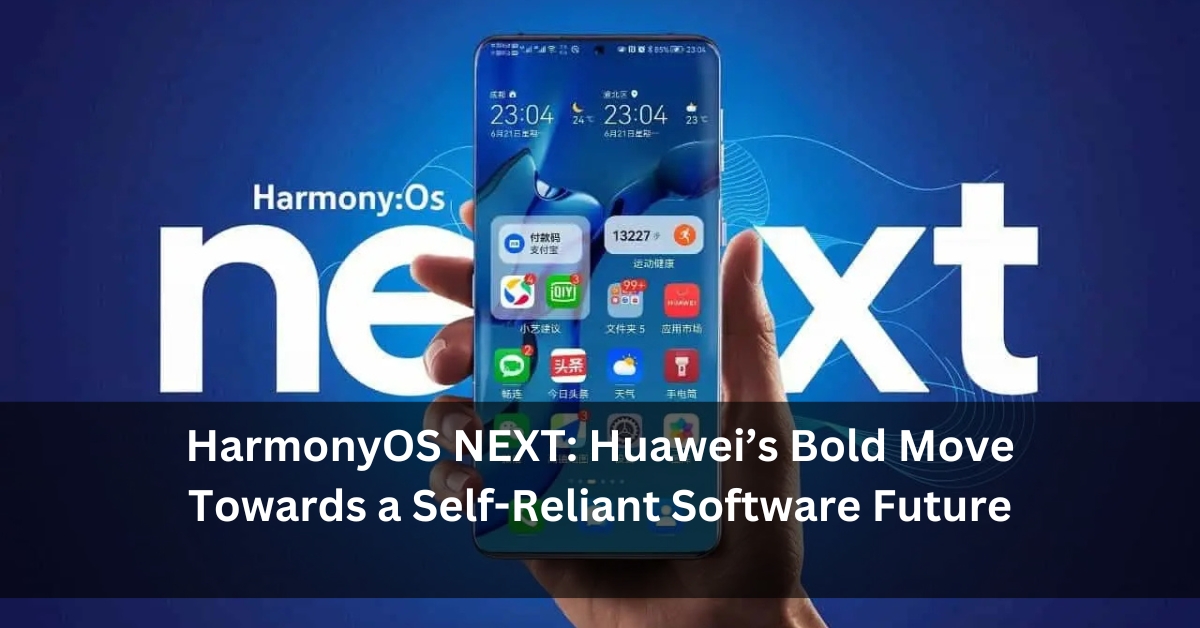HarmonyOS NEXT: Huawei’s Bold Move Towards a Self-Reliant Software Future
In a significant move to reduce dependency on foreign software ecosystems, Chinese tech giant Huawei has introduced HarmonyOS NEXT — a completely independent operating system that does not rely on Android. With this step, Huawei is not only redefining its software foundation but also offering a new path for the global tech industry. This development is especially relevant for Indian users and developers, as it signals a shift toward localised and self-reliant technology ecosystems.
FutureAI brings you an in-depth look at HarmonyOS NEXT — what it is, how it works, and what it means for the future of mobile and computing platforms.
What is HarmonyOS NEXT?
Huawei originally launched HarmonyOS in 2019 as a response to trade restrictions that limited its use of Google’s Android operating system. Earlier versions of HarmonyOS still relied on Android’s codebase. But now, HarmonyOS NEXT is built from scratch. It does not support Android apps, nor does it contain any Android or Linux components. It is a 100% native Huawei operating system.
This new platform is designed to work across a wide range of devices — smartphones, tablets, smart TVs, wearables, and even laptops. The goal is to build a unified ecosystem where apps and services communicate smoothly, offering users a consistent and efficient experience.
FutureAI believes this is a notable turning point not just for Huawei, but for the wider tech landscape, particularly in countries like India that are seeking to promote homegrown technology.
Key Features of HarmonyOS NEXT
1. Fully Independent OS
The biggest highlight is that HarmonyOS NEXT has no Android support. It cannot run Android applications. Huawei has developed a new app development framework called “HarmonyOS Core,” which is meant to encourage developers to build apps specifically for this system.
2. New App Ecosystem
With no access to the Google Play Store, Huawei has enhanced its own AppGallery. This new version of the AppGallery supports only HarmonyOS-native apps. To support developers, Huawei is offering incentives and tools for porting or creating apps for HarmonyOS NEXT.
3. Smooth Performance
Early demos and reviews show that the system is lighter and faster compared to previous hybrid versions of HarmonyOS. Huawei claims it uses fewer system resources while offering improved security and battery life.
4. Cross-Device Integration
HarmonyOS NEXT is designed for multi-device interaction. For example, a user can start a task on their smartphone and finish it on their tablet or laptop without needing to manually sync data. This feature is especially useful for productivity and home-office environments.
5. Built-in AI Features
HarmonyOS NEXT comes with enhanced AI tools, including a more intelligent voice assistant, real-time translation, and automation features. The OS is designed to learn from user habits and provide smart suggestions.
FutureAI will continue to explore how such integrated AI systems could benefit Indian users, especially in regional language support and automation.
Devices Running HarmonyOS NEXT
The new OS will first appear on Huawei’s flagship devices. These include:
- Huawei Mate 70 series: This will be the first smartphone line to run HarmonyOS NEXT out of the box.
- Huawei Pura X: A foldable phone that showcases the software’s adaptability to new hardware designs.
- Huawei MateBook Laptops: These will be among the first PCs to feature HarmonyOS NEXT instead of Windows.
Huawei is expected to expand this operating system to more devices over the next year.
What This Means for Indian Users?
While Huawei’s smartphone presence in India has reduced over the past few years, HarmonyOS NEXT could change the game. India has been advocating for digital sovereignty and the development of indigenous technology platforms. A fully independent OS like HarmonyOS NEXT aligns with this goal and could inspire similar initiatives in India.
For Indian developers, this is an opportunity to engage early with a new platform that promises growth, incentives, and future potential in global markets. Huawei is already inviting Indian app developers to join its ecosystem, offering toolkits and support in multiple local languages.
At FutureAI, we believe Indian startups and software firms should watch this development closely. This may be the beginning of a broader global shift toward diversified and secure mobile ecosystems.
Challenges and Concerns
Of course, HarmonyOS NEXT is still in its early stages. There are a few challenges ahead:
- App Availability: It may take time before the AppGallery reaches the scale of the Google Play Store or Apple App Store.
- User Adoption: Without Android compatibility, users may hesitate to switch due to the unfamiliar app environment.
- Developer Learning Curve: Developers need to learn a new set of tools and frameworks, which may delay app releases.
Despite these concerns, the move toward independence and innovation is being widely appreciated. With time, these hurdles could be resolved, especially if Huawei succeeds in building a strong developer community.
Final Thoughts
Huawei’s HarmonyOS NEXT marks a new chapter in the global operating system market. By moving away from Android, the company is setting a precedent for other tech firms to build more secure, adaptable, and localised systems. For Indian audiences, this development holds potential — not only in terms of new consumer devices but also for innovation and employment in the software sector.
At FutureAI, we will continue to track the evolution of HarmonyOS NEXT and its impact on the software and apps landscape. Stay connected with us for the latest updates, expert analysis, and deep dives into how technology is shaping our world.







